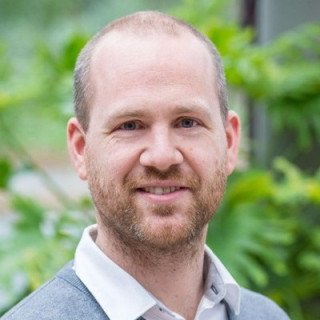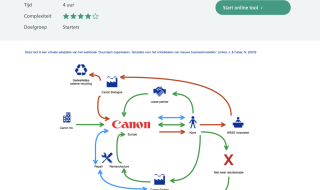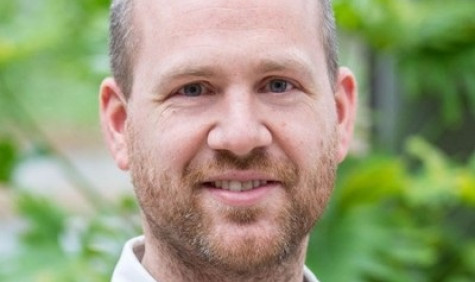The circular economy professional community only got rolling by finding a common goal
Five universities of applied sciences set up a professional community within the circular economy domain. Within the project, they wanted to gain joint experience in sharing and further developing educational resources. After some start-up problems and eventually a renewed project proposal, the professional community developed a MOOC.

Ivo Kothman
Met een achtergrond als ingenieur en productontwikkelaar weet Ivo Kothman als geen ander dat innovatie niet zonder slag of stoot tot stand komt. Net zoals Edison voorafgaand aan de ontdekking van de gloeilamp eerst duizend manieren bedacht waarop een gloeilamp níet werkt, heeft de vakcommunity circulaire economie op vele manieren ontdekt hoe je geen vakcommunity moet opstarten. De belangrijkste les volgens Kothman: 'we misten een product'. Maar ook de organisatie van het onderwijs is een belangrijke verklaring voor het falen dat voorafging aan het succes.
With a background as an engineer and product developer, Ivo Kothman knows better than anyone that innovation does not come about without a struggle. Just as Edison, prior to the discovery of the light bulb, first thought of a thousand ways in which a light bulb would not work, the circular economy trade community discovered many ways in which not to start a trade community. The most important lesson according to Kothman: 'we were missing a product'. But the organisation of education is also an important explanation for the failure that preceded its success.
Dynamic field
Lecturer and researcher Ivo Kothman had the project leadership more or less thrown at him. A project application had been made by five universities of applied sciences to start a subject community around open learning materials on circular economy, and Kothman, a lecturer at Saxion's FEM (Finance, Economics and Management) academy, was the right person to lead that project, according to the academy director. 'The trigger for the application was the fact that there is little educational material available on the circular economy,' Kothman says. 'It is a new, very dynamic field, for which there are almost no teaching methods yet.' The plan was to take stock of what the participating institutions had in terms of modules and courses and compile that in a so-called 'learning portfolio' for education and entrepreneurs. That the application was granted, they saw as a recognition of the need for the project. But Kothman soon discovered that money alone is not enough to organise a professional community.
'Money alone is not enough to organise a professional community.'
No coherent whole
'In the first project phase, it was a challenge to convert the money into hours and actions. That sounds strange, but to make hours on a project, someone has to relieve you of another task.' The moment a lesson plan from another participating institution failed to take into account the project, Kothman was left empty-handed. 'People wanted to, but didn't have the space to get seriously involved, for example, one day a week.'
A number of meetings took place and existing teaching materials were collected, but soon the budding subject community encountered a new barrier: copyright. Whereas, when developing teaching, a teacher easily plucks an image from the web, quotes a piece of text and looks for a YouTube video to go with it, open sharing of learning materials requires that all content is rights-free. Support from the institutional library did not extend as far as hoped. Kothman: "First, we had to be able to indicate where the image came from, which we sometimes did not save very cleanly. A librarian could then establish that we were not allowed to use an image, but was not professionally competent to suggest an alternative. We then had to do that again ourselves.'
Making the collected learning materials publicly available in a learning portfolio also proved challenging because there was no accessible online platform available. And time was running out. 'There was no coherent whole yet, let alone a publicly shared portfolio,' says Kothman. While the trade community struggled with these hurdles, corona was knocking on the door. The workload shot up and the project came to a grinding halt.
Deux ex machina
It could have run aground there for good, were it not for the fact that one day, like a veritable deus ex machina, Radboud University professor Jan Jonker contacted Kothman. Jonker is author of the book'Sustainable Organising', to which the project partners had contributed at an earlier stage. 'Jonker wanted to develop a digital course to support the book,' says Kothman. 'His goal was very similar to ours. We decided to join hands and develop a MOOC (massive open online course) together.'
With the development of the MOOC Organising for Sustainability, the community had a clear goal in mind. Everyone knew what they were working on. The structure of the book provided guidance for building the MOOC. Moreover, everyone involved was familiar with the content. A nice side effect was that the partnership suddenly became much larger: more institutions contributed to the book. As a result, twelve institutions now participate in the professional community.
'With a MOOC as a common goal, we gained momentum.'
New proposal
'Jan Jonker took on a special role,' says Kothman. 'He brought in a lot of expertise and connections. He also took over pulling the cart. I overestimated the amount of work that entailed.' Kothman himself had to convince SURF and the Ministry of Education, Culture and Science that the MOOC was the solution to realise the objectives in the application. Fortunately, the funding body was flexible. 'They thought constructively with us. We were given the freedom to submit a renewed proposal with the remaining piece of the budget.' SURF and OCW felt that a slightly longer lead time and a small change in direction were preferable to a subject community dying a quiet death.
The proposal solved all the original barriers. Saxion already had a MOOC platform, edX. A reallocation of the budget meant there was room to hire professionals: a designer, an editor, a company that edited the self-shot videos. The results are worth noting. ''Perhaps it was naive of us to have almost only teacher hours in the original budget,'' Kothman now says. ''These are skills that teachers don't all have in-house.'' By making (or having made) all the materials ourselves, copyright no longer posed a problem.
Potential in tools
All's well that ends well? Up to a point. The MOOC now has 667 active unique users. To update it, Kothman again depends on teachers' free hours. He also sees his own schedule filling up. 'Redevelopment should have a regular place in our work. But we are not that far yet.'
Meanwhile, he does get enthusiastic responses from students, who are excited about the short explainer videos from the MOOC. Teachers are particularly pleased with the tools developed by the subject community. These include a template for jointly filling in a business model online (919 unique users) and a drawing tool for drawing a circuit in the style of the MOOC (1944 unique users). According to Kothman, online tools are the future. 'Packaging your knowledge and skills in an accessible tool is attractive. As an instructor, you add content yourself, so a tool does not become obsolete quickly.'

A Circular Economy (subject) community for high-quality blended education
Five universities of applied sciences - Saxion, Hanzehogeschool, Van Hall Larenstein, Fontys and Rotterdam University of Applied Sciences - wanted to share time- and location-independent open education via a subject community. The idea was that they would reuse existing learning materials, develop them further and develop missing learning materials themselves. Eventually, the project plan was adapted and the MOOC Organising for Sustainability was developed.
The project was part of the Open and Online Education Incentive Scheme, within the Open Educational Resources pillar.
Text: Marjolein van Trigt
